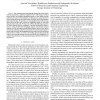Free Online Productivity Tools
i2Speak
i2Symbol
i2OCR
iTex2Img
iWeb2Print
iWeb2Shot
i2Type
iPdf2Split
iPdf2Merge
i2Bopomofo
i2Arabic
i2Style
i2Image
i2PDF
iLatex2Rtf
Sci2ools
INFOCOM
2005
IEEE
2005
IEEE
Non-pipelined relay improves throughput performance of wireless ad-hoc networks
—The communication model typically assumed in wireless ad-hoc networks is based on a traditional “pipelined relay” (PR) strategy. In PR, an end-to-end flow has multiple outstanding packets (or data units) along the path from the source to the destination. In this paper, we argue that due to several unique properties of wireless ad-hoc networks, PR can be fundamentally improved upon. We present a new non-pipelined relay (nPR) strategy, where end-to-end flows have exactly one outstanding packet (or data unit) along the end-to-end path. We show that nPR has the following properties: (i) Under idealized network conditions, it provides performance improvement, in terms of end-to-end throughput capacity and network transport capacity over PR, and achieves proportional fairness; and (ii) Under practical network conditions, it further increases the above performance improvements, both in terms of the throughputs achieved, and in terms of the fairness between flows. Finally, we present...
| Added | 25 Jun 2010 |
| Updated | 25 Jun 2010 |
| Type | Conference |
| Year | 2005 |
| Where | INFOCOM |
| Authors | Aravind Velayutham, Karthikeyan Sundaresan, Raghupathy Sivakumar |
Comments (0)

